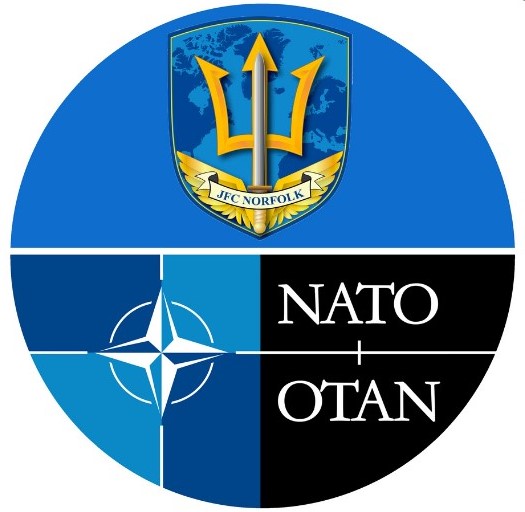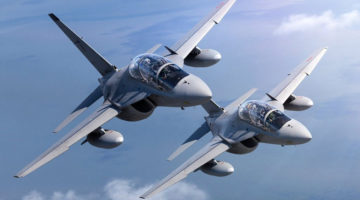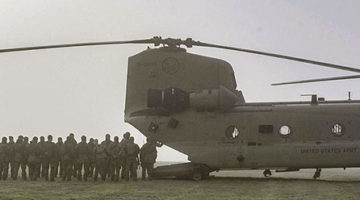By Robbin Laird and Ed Timperlake – An Interview with French Navy Rear Admiral Hilaire Ducellier, head of plans, Joint Force Command, Norfolk [1]
The standup of both Second Fleet in 2018 and Joint Force Command, Norfolk in 2019 have had very similar goals: how to enhance the combat capability of the entire allied maritime force in the North Atlantic? From this point of view, these are not two commands under Vice Admiral Lewis, but two interactive commands working a more effective distributed integrated force.
Post-2014, in the wake of the Crimean takeover, the United States and a number of core allied nations, reversed course on the Cold War peace dividend and engagement in the Middle East land wars and began to refocus on the challenges posed by the Russians with the return of direct defense challenges in Europe. And with it the need to rebuild North Atlantic 360-degree sea lines of communication was a key challenge.
This is how Rear Admiral Waddell, the Vice Commander of C2F has put the challenge:
“The old 2nd Fleet was interested in sea lines of communication. But the new 2nd Fleet is focused on strategic lines of communication. This is an all-domain perspective, and not just the convoy missions of past battles of the Atlantic.”
He referred to C2F as the maneuver arm in providing for defense, deterrence and warfighting but as part of a whole of government approach to defending the United States, Canada and NATO allies against threats.
What JFC Norfolk facilitates is more effective coordination of the relevant nation’s responses to the new threat environment and to work ways to forge these efforts into a more integrated approach, one which enhances the lethality, survivability and effectiveness of the fleets involved in North Atlantic defense.
Vice Admiral Lewis noted at the time of JFC Norfolk reaching its Initial Operational Capacity of how important the working relationship between C2F and JFC Norfolk was for shaping a comprehensive and integrated way ahead for Atlantic defense. As a September 2020 USNI article put it :
“This is the first command of its type within NATO,” Lewis said. “It’s the first command on the continent of North America that NATO has established in a long time.”
While Lewis leads JFC Norfolk, he noted that his deputy commander is U.K. Royal Navy Rear Admiral Andrew Betton. The command also includes three one-star leadership positions held by one officer from Denmark, one from France, and one from Norway, Lewis said. JFC Norfolk’s chief of staff will toggle between an officer from Spain and Germany. Meanwhile, Lewis’ deputy for his 2nd Fleet command is Canadian Rear Admiral Steve Waddell.
“JFC Norfolk will make our lives stronger and help defend North America as well as Europe, by providing continued situational awareness across the North Atlantic, deterring aggression, and if necessary, rising to defend our shared values,” Lewis said. [2]
Below is an abstract of an interview conducted this month with French Navy Rear Admiral Hilaire Ducellier, currently head of plans at JFC Norfolk. A very experienced naval officer with service in both the Pacific and the Atlantic/Mediterranean regions, Rear Admiral Ducellier has commanded three ships throughout his career and the Maritime Operational Center for the Atlantic.
The French Navy is a somewhat unique asset within the European region, as it has operated full spectrum maritime operations throughout the Cold War and after, with carriers, boomers, nuclear attack submarines, maritime patrol aircraft and has a robust maritime strike missile capability as well. It is both a conventional and nuclear navy with its carriers carrying nuclear qualified Rafale pilots onboard as well.
It is also a navy which operates globally, as the recent operations of a nuclear attack submarine in the Pacific clearly demonstrates.
Rear Admiral Ducellier highlighted that France is focused on coalition operations with its maritime force throughout the Cold War, into the period up to 2014, and into the post-2014 period. And the new JFC is not replicating what is being done in Naples.
“We are a lean command. You are not going to do with a 150 in our command what you can do with 1,000 in Naples.”
In keeping the command lean and focused on coalition warfighting there is a huge opportunity to leverage the modernization efforts of the United States and the relevant nations to sort through how to make best use of one another’s capabilities, through coalition exercises and cross learning, rather than shaping a large top-down bureaucratic effort.
Rear Admiral Ducellier highlighted that the coalition approach through a connected C2 structure provides for significant flexibility on how the key aspects of the force can work creatively together.
“Rather than characterizing platforms as primarily a supporting or supported capability, we are seeing much more flexibility whereby a platform can play a role as either a supporting or supported capability dependent on the mission.” Distributed modular task forces can provide redundancy, flexibility, and enhanced survivability for the overall combat fleet.
Clearly, the approaches being pioneered by C2F and JFC Norfolk can provide a significant impact to rethinking C2 and distributed combat capability through coalition integration in the period ahead.
[1] This article is an abstract of a story and a series which initially appeared on sldinfo.com (see: https://sldinfo.com/2021/03/enhancing-coalition-combat-capability-the-role-of-joint-force-command-norfolk/) and published here with the authorization of the authors.
[2] See: https://news.usni.org/2020/09/17/joint-force-command-norfolk-reaches-initial-operational-capability, as quoted in >>> https://sldinfo.com/2021/03/the-role-of-allied-joint-force-command-norfolk-in-atlantic-defense-the-perspective-of-its-deputy-commander/
Illustration © Twitter JFC











